Ijraset Journal For Research in Applied Science and Engineering Technology
- Home / Ijraset
- On This Page
- Abstract
- Introduction
- Conclusion
- References
- Copyright
Global Publication Output of Tinospora cordifolia (Medicinal Plant) Research: A Scientometric Study
Authors: Dr. Satish Kumar, Dr. Subhash Chand, Dr. Deepmala, Dr. Asha Masih
DOI Link: https://doi.org/10.22214/ijraset.2023.55516
Certificate: View Certificate
Abstract
Scientometrics is described as a technique for analysing a researcher\'s quantitative research output. This study examines scientometric analysis on Tinospora cordifolia, medicinal plant by measuring the year-wise distribution of articles, annual growth rate, authorship pattern, author productivity, relative growth rates, article doubling time, degree of author collaboration, ranked list of authors, and distribution of publications output by broad topic areas. By observing the output, we found that a maximum of 166 articles (25.75%) were published in 2021. According to the authorship pattern, 40 publications out of 1054 were written by a single author. There are 227 two-author papers, 216 three-author papers, and 206 four-author papers. Author productivity is 0.238. This indicates that production per author is just 23.80% on average, while the average number of authors per manuscript is 4.20. The average doubling time is 0.969 and the relative growth rate (RGR) is 0.68. The overall cooperation rate is 0.96. India ranks first, having published 900 articles (0.85%) out of a total of 1054 articles. By publishing 22 publications, Maharishi Dayanand University and Banaras Hindu University have taken the lead. The University Grants Commission funded 52 articles, with Dabur, R ranking first with 12 papers published.
Introduction
I. INTRODUCTION
Medicinal plants have long been important and are used as primary sources healing from diseases. A long history of medicinal plants has been used to treat ailments by humans based on instinct, taste, and experience. And hence the research on medicinal plants has attracted many researchers to analyse medicinal plants. Recently, during the Covid-19, it was used tremendously. Among many different medicinal plants, Tinospora cordifolia (Giloy), has proved to be effective medicinal plant.
Tinospora cordifolia is a wide evergreen climbing vine with several branches. It has simple, roundish leaves. It has reddish-colored fruits. This medicinal plant’s fruits grow in bunches. This herb is used in Ayurveda to cure a variety of ailments. Tinospora cordifolia is commonly known as heart leaved Moonseed Plant (English), Amrita Guduchi (Sanskrit), Giloy (Hindi), Gulancha (Bengali), Galo (Gujrati) and Teppatige (Telugu), It is found throughout India, and also in Sri Lanka, Bangladesh and China. Mittal, Sharma and Batra 1 described the importance of Tinospora cordifolia in the treatment of various diseases such as viral infections, cancer, diabetes, inflammation, leukemia neurological, immunomodulatory and psychiatric conditions it relaxes norepinephrine induced contractions. It is anti-microbial, anti-hypertensive and anti-viral Sangeetha et al. 2 assessed oxidative stress and distorted carbohydrate metabolism activities in rats related to type 2 diabetes. The stem of Tinospora cordifolia is widely used in regulating the blood glucose (by promoting insulin secretion and inhibitor for gluconeogenesis and glycogenosis). Zinjarde, Bhargava and Kumar 3 explained that in Tinospora cordifolia major phytoconstituents are Alkaloids, tannins, cardiac glycosides, flavonoids, saponins, and steroids. Uma Maheswari and Prince 4 performed research on the root extract of Tinospora cordifolia and concluded that the root extract of this plant can decrease the levels of glycosylated hemoglobin, plasma thiobarbituricacid, hydroperoxides, ceruloplasmin and vitamin E in diabetic rats. Sinha et al. 5 reviewed that Tinospora cordifolia has been used in indigenous medical systems as described in various classical texts of the Ayurvedic system of medicine. Charak, Sushrut, Ashtang Hridaya and other ancient treaties. It is also specifically mentioned for its use in tribal and folk medicine in various parts of India.
Scientometrics, a field of information science concerned with the use of bibliometrics, is necessary to investigate the scientific concepts found in the published literature in all of its forms.
According to the Glossary of Thompson Scientific Terminology 6, “Scientometric is the quantitative study of the disciplines of science based on published literature and communication. Scientometric can identify innovative and emerging areas of scientific research; examine their development over the time and over the geographical location. According to Dobrov and Korennoi 7, ‘Scientometrics’ and bibliometrics, both carry the same meaning.
Merton and Garfield 8, stated that scientometric as ‘the field of enquiry given over to the quantitative analysis of science and scientific field’.
II. REVIEW OF LITERATURE
García-Ávila, F. et al.9 analysed Application of ornamental plants in constructed wetlands for wastewater treatment using Scientometric technique from 2002 to 2022 using Scopus database. Mexico, Brazil, USA, China and India have the highest number of publications in the field of ornamental plants in the CWs and the most used ornamental plants are Canna, Iris, Heliconia and Zantedeschia.
Chaman Sab M. et al.10 assessed Ethnopharmacology Research: A Scientometric Assessment of Indian Publications During 2011 to 2020 Web of Science (WoS) database Total 7,159 papers were retrieved , consisting of 84.24% journal articles and 14.23% review articles. The Council of Scientific Industrial Research (CSIR) India collaborates with the Indian Council of Agricultural Research (ICAR) and Central Institute of Medicinal Aromatic Plants (CIMAP) in terms of domestic collaboration.
Haungm Z. et al.11 studied and analysed Medicinal and Edible Plant Coptis a total of 367 documents were analyzed. China (214) is at top position followed by Japan (57) and South Korea (52). The anti-oxidative stress, pharmacokinetics, and Alzheimer’s disease treatment of Coptis are new hotspots in this field.
Atlasi et al. 12 carried out a scientometric analysis on herbal medicines used in the treatment of COVID-19. Data is retrieved from Web of Science (WOS) and Scopus database published till 26 October 2020. A total of 3185 records were analysed. Original and review articles have been the two predominant varieties of papers in each database. Major subject areas are drugs and medicine, respectively in WOS and Scopus databases.
The top three productive countries are China, US and India. “Journal of Biomolecular Structure Dynamics” in WOS and “Chinese Traditional and Herbal Drugs” in Scopus have been the top journals. Top keywords are “COVID-19′′ and “Traditional Chinese Medicine”. US is at top in collaboration with different authors.
Sivankalai and Sivasekaran 13 analyses the global level outlook of research publications on Mucormycosis output between the period of 1923 to 2021 (May). 4451 publications downloaded from core collection of Web of Science database. First publication was in 1923. 3798 institutions and 8562 different disciplines contributed and 2808 publications were in Articles. 4451 publications were published by 17320 authors and 23552 collaborations, documents per author is 0.257, authors per document are 3.89. First article published in 1923 was in German language. Total records published in 1161 journals, eleven languages, ninety-five countries and 1504 are open access and 12 articles are highly cited in this field.
Kumari, Amsaveni and Surulinathi 14 performed scientometrics analysis in the field of Occupational Therapy research output during the period of 1989 to 2015. The data is retrieved from the Web of Science. A total of 8095 publications were found the highest number of publications were published in 2013. In 2007, 386 publications were published with highest Global Citation Score of 6525. In Global Citation Scores, University of Queensland tops followed by the University of Toronto. India is at 25th position in the global ranking.
Jeyshankar and Babu 15 have assessed scientometric analysis of leukemia research on Indian contributions between 1960 to 2011. The data is retrieved from Scopus database. Out of 29 states in India, only 20 states contributed 2120 records. New Delhi ranked first, followed by Chandigarh, Maharashtra.
Surulinathi, Balasubramani and Kalidhasa 16 analysed the growth and development of Green Computing. A total of 3324 records are found in Web of Science from the period 1956-2011. Germany is at top by publishing 270 (16.24 %) articles followed by France and Italy, UK and Spain contributed more than 100 articles. India is also a leading country by publishing 128 Articles.
Gupta and Bala 17 have analysed the research output of India (Citation analysis of theoretical population genetics literature). The ten years of data was retrieved from Scopus using the keyword alzheimer disease. USA is at top with 25% publications followed by UK (16.20 %). India with 900 publications is on 16th position among top 20 countries. All India Institute of Medical Sciences (AIIMS), New Delhi have highest publications but University Institute of Pharmaceutical Sciences, Punjab Chandigarh got highest h-index (26) with 35 publications.
III. OBJECTIVES OF THE STUDY
This study has the following objectives:
- To study year-wise distribution of the articles published during 2011 to 2021.
- To find annual growth rate of articles.
- To reveal authorship pattern and author productivity.
- To check the co-authorship network.
- To examine Relative Growth Rates and Doubling Time of articles.
- To classify the Degree of authors collaboration
- To studycountry wise and subject -wise distribution of articles.
- To identify and prepare the ranked list of authors.
- To study the distribution publications output by broad subject areas.
IV. RESEARCH METHODOLOGY AND LIMITATION OF THE STUDY
The required data was collected from Scopus database for the period 2011to 2021. It can be seen that 1054 research articles retrieved from this database on Tinospora cordifolia medicinal plant. The researcher downloaded the data and analysed the data with the help of MS Excel software as per the objectives of the study and the VOSviewer software was used for visualization of Co-authorship network. Various statistical methods are used to calculate AGR, RGR, Doubling Time, Author productivity and degree of authors collaboration.

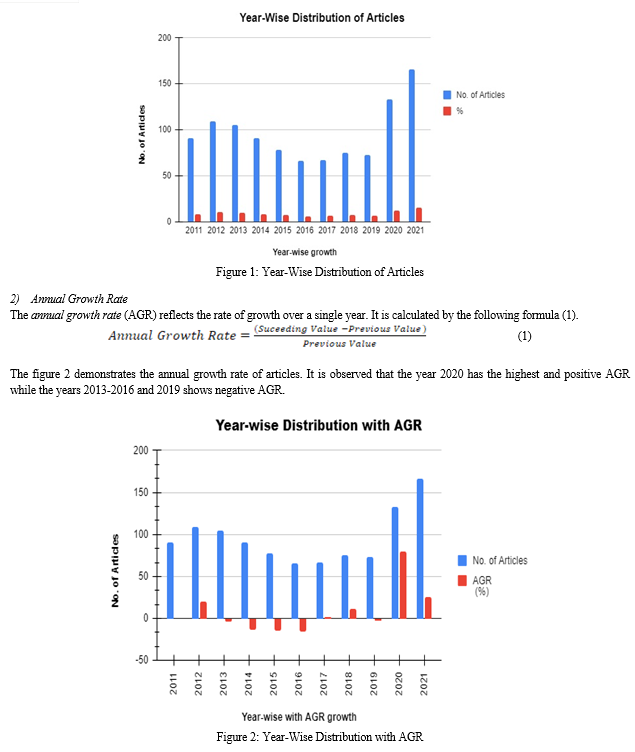
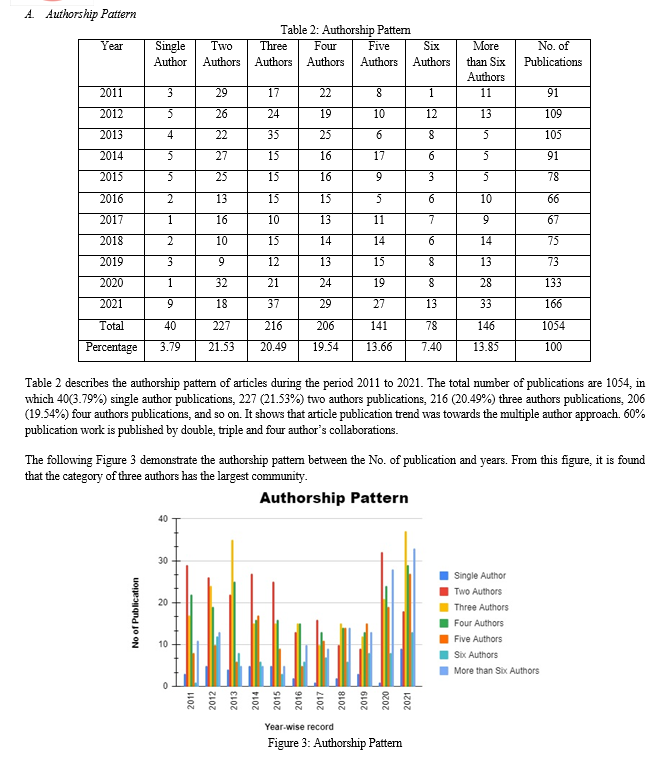
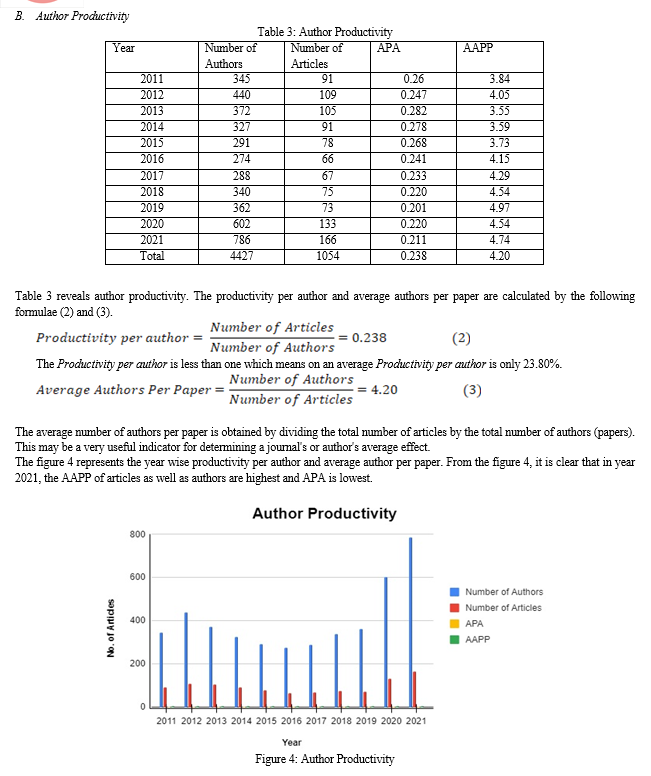
C. Co-authorship Network
Figure 5 displays the visualisation of the co-authorship network. Networks were created using the VOS viewer Software (https://www.vosviewer.com/), which was used to evaluate data obtained from Scopus. The figure's node symbol stands in for the author, while the size of the node denotes the author's activity and the curving line connecting the two authors denotes their relationship of collaboration. The co-authorship network is analysed with respect to the highest document-wise, citation-wise and total link strength-wise.
- Document-wise Co-authorship Network: With 19 documents in collaboration, each in collaboration, Kumar a., Kumar s., and Singh a. have equal but highest contributions and have the first rank. Subsequently, Sharma p. and Sharma a. had 17 documents each and got the second rank. Additionally, Singh s. (14), Singh s., and Sharma s. (13) are in the rank list.
- Citation-wise Network: Considering the highest citation-wise, Dhama k., Latheef s. k., and Samad h. a., achieved the top (419) citations equally. Subsequently, Tiwari r. (381), Sharma p. (365), and Kumar a. (364) have achieved the good citation score.
- Total Link Strength: For the link-wise analysis, we have found that Kumar a. has the strongest connection among others, with 29 links. Patwardhan b. comes in second with 25 connections, followed by Chopra a. with 24 connections and Bichie l. with 23 connections.
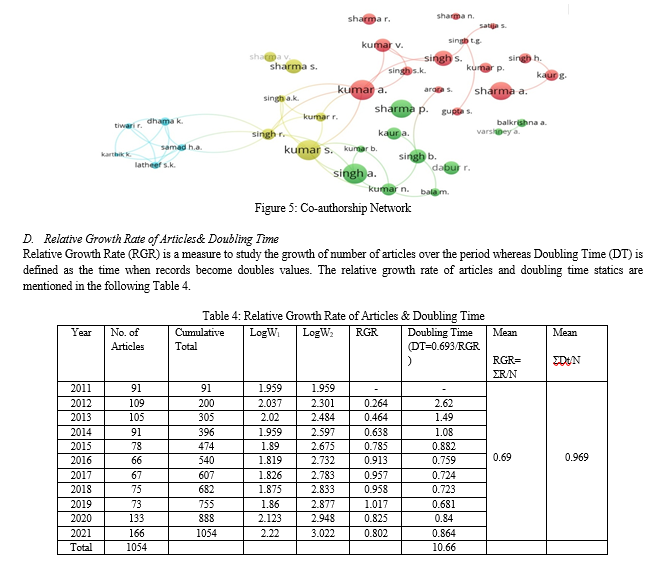
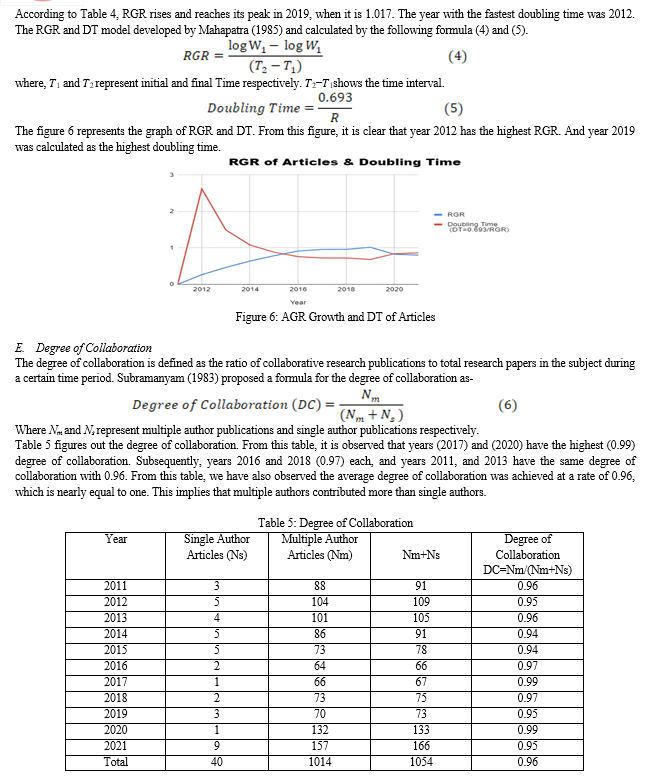
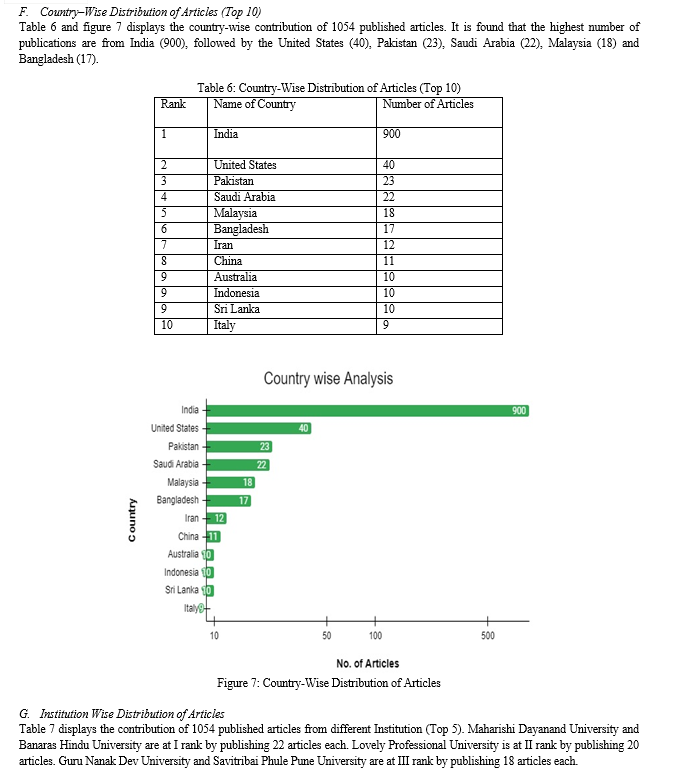
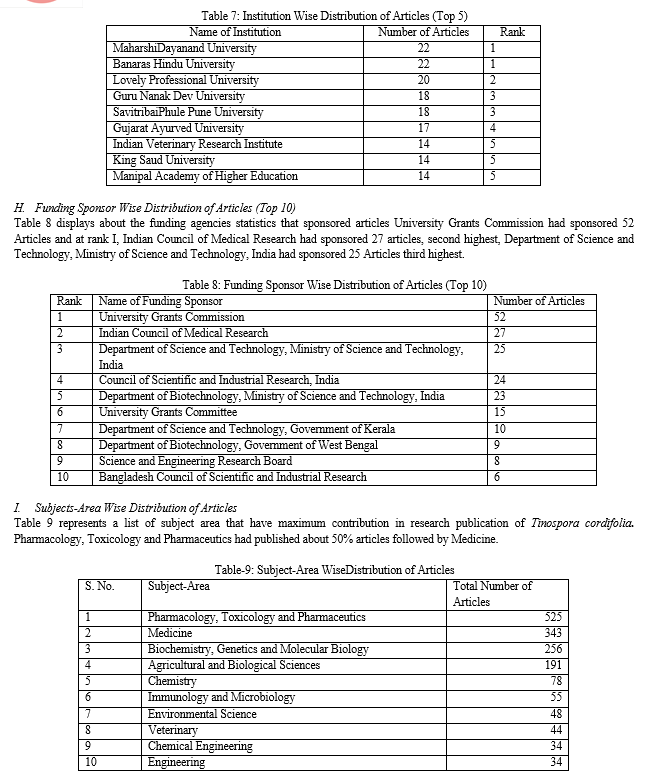
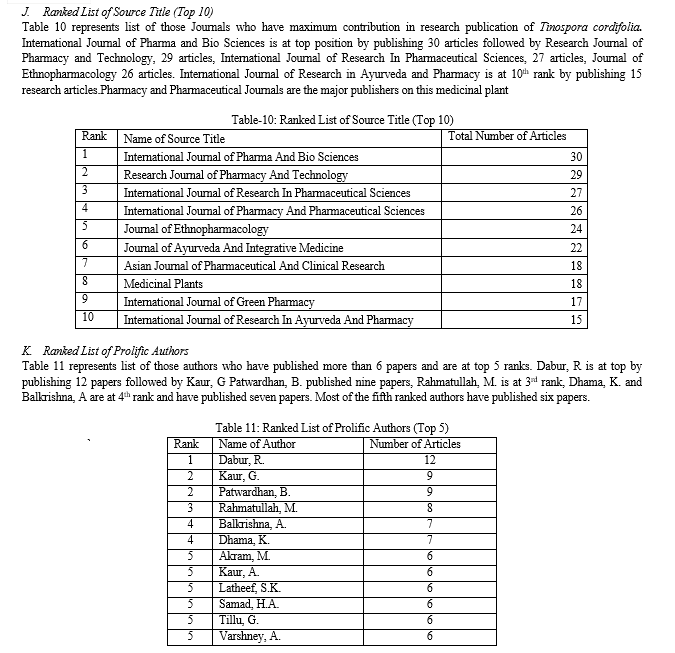
Conclusion
For studying Tinospora cordifolia (Medicinal Plant), we fetched ‘1054’ articles from the year of 2011 to 2021 using the Scopus database. We have examined such articles based on different scientometric parameters. 1) It is found that in year 2021 maximum no. of articles 166 (25.75%) were published. In year 2016, lowest no. of articles were published. 2) It is analyzed by authorship pattern that 40 articles out of 1054 are of single author. 227 of two authors, 216 of three authors and 206 of four authors. 3) Productivity per author is 0. 238. This is less than one. It means on an average Productivity per author is only 23.80% and Average authors per-paper is 4.20. 4) Relative Growth Rate (RGR) of publication of articles related to Tinospora cordifolia is 0.68 and average of Doubling time is 0.969. 5) The overall degree of collaboration was 0.96. And 40 articles are of single authored publications and 1014 articles are multi authored. 6) India is a top position by publishing 900 articles (0.85%) out of 1054 articles. 7) Maharishi Dayanand University & Banaras Hindu University are at I rank by publishing 22 articles. 8) University Grants Commission had Sponsored 52 articles and is at rank I, whereas Indian Council of Medical Research had Sponsored 27 article and is at rank II. 9) In research publication of Tinospora cordifolia . Pharmacology, Toxicology and Pharmaceutics had published 50% articles followed by Medicine. 10) International Journal of Pharma and Bio Sciences is at top position by publishing 30 articles followed by Research Journal of Pharmacy and Technology, 29 articles. 11) Dabur, R is at top by publishing 12 papers.
References
[1] Mittal, J., Sharma, M. M., & Batra, A. (2014). Tinospora cordifolia: A Multipurpose Medicinal Plant-A Review. Journal of Medicinal Plants Studies, 2(2),32-47. [2] Sangeetha, M. K., Balaji Raghavendran, H. R., Gayathri, V., & Vasanthi, H. R. (2011). Tinospora cordifolia attenuates oxidative stress and distorted carbohydrate metabolism in experimentally induced type 2 diabetes in rats. Journal of natural medicines, 65, 544-550. DOI: https://doi.org/10.1007/s11418-011-0538-6 [3] Zinjarde, S. S., Bhargava, S. Y., & Kumar, A. R. (2011). Potent ?-amylase inhibitory activity of Indian Ayurvedic medicinal plants. BMC complementary and alternative medicine, 11(1), 1-10. [4] Umamaheswari, S. E. L. V. A. R. A. J., & Prince, P. S. M. (2007). Antihyperglycaemic effect of ëilogen-excelí, an ayurvedic herbal formulation in streptozotocin-induced diabetes mellitus. Acta Poloniae Pharmaceutica ñ Drug Research, 64(1), 53-61. [5] Sinha, K., Mishra, N. P., Singh, J., & Khanuja, S. P. S. (2004). Tinospora cordifolia (Guduchi), a reservoir plant for therapeutic applications: A Review. . Indian Journal of Traditional Knowledge. 3(3), 257-270. [6] Scientometrics (2008). Glossary of Thompson Scientific Terminology online. Retrieved from http://science.thomsonreuters.com/support/patents/patinf/terms/> [7] Dobrov, G. M., & Karennoi, A. A. (1969). The informational basis of scientometrics. On theoretical problems of informatics. Moscou: VINITI. FID, 435, 165-191. [8] Merton, R. K., & Garfield, E. (1963). Forward to Little Science, Big science and Beyond by DJ de solla Price. New York: Columbia University press. [9] García-Ávila, F., Avilés-Añazco, A., Cabello-Torres, R., Guanuchi-Quito, A., Cadme-Galabay, M., Gutiérrez-Ortega, H., ... & Zhindón-Arévalo, C. (2023). Application of ornamental plants in constructed wetlands for wastewater treatment: A scientometric analysis. Case Studies in Chemical and Environmental Engineering, 7, 100307. [10] Chaman Sab, M., Kappi, M., & Ahmed, K. M. (2022). Ethnopharmacology Research: A Scientometric Assessment of Indian Publications During 2011 to 2020. Journal of Pharmacology and Pharmacotherapeutics. https://doi. org/10.1177/0976500X221082839. [11] Huang, Z., Hou, Z., Liu, F., Zhang, M., Hu, W., & Xu, S. (2021). Scientometric analysis of medicinal and edible plant coptis. Frontiers in Pharmacology, 12, 725162. [12] Atlasi, R., Ramezani, A., Tabatabaei-Malazy, O., Alatab, S., Oveissi, V., & Larijani, B. (2022). Scientometric assessment of scientific documents published in 2020 on herbal medicines used for COVID-19. Journal of Herbal Medicine, 35, 100588. DOI: https://doi.org/10.1016/j.hermed.2022.100588 [13] Sivankalai, S., & Sivasekaran, K. (2021). Mucormycosis (black fungus) maiming Covid patients: Scientometrics analysis through prism of Biblioshiny. Libr Philos Pract, 5546. https://digitalcommons.unl.edu/libphilprac/5546 [14] Prasanna Kumari, N., Amsaveni, N., & Surulinathi, M. (2015). Scientometrics Analysis in the field of Occupational Therapy: a global level perspective. International Journal of Next Generation Library and Technologies, 1(2), 1-7. [15] Jeyshankar, R., & Babu, B. R. (2013). Scientometric analysis of leukemia research output (1960-2011): An Indian perspective. Asia Pacific Journal of Library and Information Science, 3(2). [16] Surulinathi, M., Balasubramani, R., & Kalisdha, A. (2013). Continent wise Analysis of Green Computing Research: a scientometric study. Journal of Advances in Library and Information Science, 2(1), 39-44. [17] Gupta, B. M., & Bala, A. (2013). Alzheimer’s disease research in India: A scientometric analysis of publications output during 2002-11. Research in Neurology: An International Journal, 2013, 204542. DOI: 10.5171/2013.204542
Copyright
Copyright © 2023 Dr. Satish Kumar, Dr. Subhash Chand, Dr. Deepmala, Dr. Asha Masih. This is an open access article distributed under the Creative Commons Attribution License, which permits unrestricted use, distribution, and reproduction in any medium, provided the original work is properly cited.

Download Paper
Paper Id : IJRASET55516
Publish Date : 2023-08-26
ISSN : 2321-9653
Publisher Name : IJRASET
DOI Link : Click Here
 Submit Paper Online
Submit Paper Online

